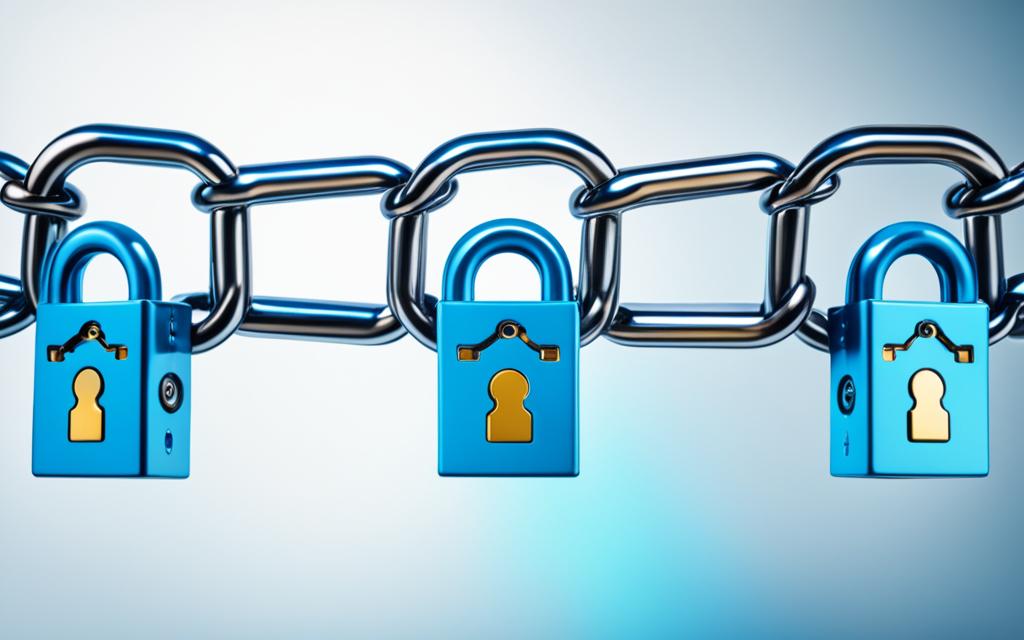Table of Contents
A hash function changes input text into a fixed-length hash value. It’s crucial for blockchain security. Hash functions come with special properties to keep the blockchain safe. These include making sure data can’t be easily changed, ensuring each block has a unique marker, and protecting against alterations.
For example, Bitcoin uses SHA-256 and Litecoin uses Scrypt1. These unique identifiers make sure transactions are real and safe from changes1. In a blockchain, new blocks reference the last block’s hash. This creates a chain making sure data isn’t tampered with2.
Hash functions are designed to stop anyone from changing the data easily1. This means each block has its own unique code. This helps spot errors or fraud. Miners in blockchain use special codes to protect the network1. Hashing also makes sure our digital signatures are secure, keeping transactions safe1.
Key Takeaways:
- Hash functions are key for making blockchains safe by creating special codes for data blocks1.
- Blockchains link each block by referring to the last one, which keeps the data safe2.
- Hashing helps make sure data in blockchains stays unchanged2.
- Both public and private blockchains use hashing to keep their data secure2.
- Hash functions support blockchain security measures like Proof-of-Work and Proof-of-Stake2.
2. Link 2
How Hash Functions Work
Hash functions are key in making blockchain secure. They create unique, fixed-size outputs from inputs, such as transactions. This is done using special hash algorithms. Think of these outputs as digital fingerprints for data.
The special thing about hash functions is they always give the same output for the same input. It means you can check if data has changed. And you can do this securely.
Change even one small thing in the input, and the output changes a lot. This makes it extremely hard to figure out the original input from the hash.
For Bitcoin, the SHA-256 algorithm3 is used. Miners work to find the right hash to add a new block to the blockchain4. They adjust a piece of the input, called a nonce, trying different values until they find the correct one. This process is both power-hungry and needs a lot of computational effort4.
SHA-256 gives a fixed-length output in hexadecimal format. It makes the data uniform and acts as a unique flag for each piece of data. Different hash algorithms give different output lengths, like 32-bit or 64-bit5.
Hash functions have an important ability. They ensure that different pieces of data get unique hash values. This helps make sure one piece of data isn’t mistaken for another, strengthening the security of the system5.
| Hash Function | Year of Invention/Development |
|---|---|
| MD4 | 1990 |
| MD5 | 1992 |
| MD6 | 2008 |
| SHA-1 | 1995 |
| SHA-2 | 2001 |
| SHA-256 | 2001 |
Table: Chronological Overview of Hash Function Development
Hash functions help with more than just blockchains. They’re big in online security. They protect passwords, spot data leaks, and check file safety during downloads. Hash tables use hash functions to quickly find duplicates in big sets of data, making systems more efficient4.
Types of Cryptographic Hash Functions
Cryptographic hash functions are key in keeping blockchain data safe. They take any data size and turn it into fixed-sized digests. These digests are unique and almost never the same.
There are different types of hash functions. Each offers a specific level of safety and speed.
RIPEMD
RIPEMD is a well-known type of hash function. The full name is RACE Integrity Primitives Evaluation Message Digest. It comes in versions like RIPEMD-128, RIPEMD-160, RIPEMD-256, and RIPEMD-320.

The popular RIPEMD-160 makes a 160-bit output from data. It works well for many needs and is common in blockchains.
Message-Digest Algorithm (MD)
MD is another class, including MD2, MD4, and MD5. MD5 is especially famous. It’s widely used for protecting data.
MD5 turns a 512-bit text into a 128-bit code. It helps keep passwords and other data safe.
BLAKE2 and BLAKE3
BLAKE2 and BLAKE3 are new designs to replace older models. BLAKE2 is fast and fits many software types.
BLAKE3 came in 2020. It’s meant to be faster, with new features like XOF and KDF.
Whirlpool
Whirlpool makes a 512-bit code when used. It started in 2000 and is now found in many places.
Secure Hashing Algorithm (SHA)
SHA works in different ways, like SHA-0, SHA-1, SHA-2, and SHA-3. SHA-256, from the SHA-2 group, is vital for blockchains.
SHA-256 creates a strong 256-bit code. It helps keep blockchains secure. The NSA made it in 2001.
Hash functions protect blockchains in many ways. They help with Merkle Trees, the Proof of Work system, digital signatures, and secure block chains through hash levels68.
| Hash Function | Description |
|---|---|
| RIPEMD | Consists of RIPEMD, RIPEMD-128, RIPEMD-160, RIPEMD-256, RIPEMD-320 |
| MD5 | Generates a 128-bit digest from a 512-bit string |
| BLAKE2 | Announced in 2012 as a replacement for MD5 and SHA-1 |
| BLAKE3 | Introduced in 2020, based on Bao and BLAKE2 |
| Whirlpool | Produces a 512-bit hash value |
| SHA-256 | Part of the SHA-2 family, extensively used in blockchain technology |
| SHA-3 | Chosen as the new standard in 2012 based on the Keccak algorithm |
Uses of Hash Functions in Blockchain
Hash functions are vital in making blockchain technology secure and work smoothly. They help in many parts of blockchain, like making Merkle Trees to ensure the safety of block headers and transactions9. These trees use hash functions to group transaction lists in a way that keeps everything secure and easy to check.
A main use of hash functions is seen in the Proof of Work consensus algorithm9. This method needs hash functions that are strong against collisions to confirm blocks9. Miners work to solve tough puzzles using these functions. They look for hash values under a certain level to prove their work and keep the system safe from harm.
They are also key for digital signatures in blockchain dealings9. Digital signatures rely on advanced maths, including hash functions, to make sure data is kept safe and real10. A unique hash is made from the transaction data, then locked with the sender’s secret key. This digital stamp can be checked with the sender’s open key. This check makes sure the transaction isn’t changed and that the sender is who they say they are.
Hash functions have a big part in forming and sustaining the chain of blocks in blockchain9. Each block gets a hash from its data and the previous block’s header hash9. This action links the blocks in a way that if any block is changed, everyone knows because it affects the chain.
To sum up, hash functions are fundamental for blockchain’s security, honesty, and validity. They make it easy to check, agree, and stop unwanted changes9. As blockchain grows in use in many fields, hash functions stay essential for a safe and clear system for dealing with transactions.
The Importance of Hashing in Data Verification
Hashing is key in keeping data safe in blockchain tech. It makes unique hash codes from data, like digital fingerprints. This means we can check if info is real.
A famous hash function, SHA-25611, turns data into small hash codes. These codes act as fingerprints. They quickly tell us if data has changed or not.
One big plus of hashing is spotting data changes12. Even tiny changes make a hash code very different. So, we can see if info has been messed with. This keeps our data safe.
Using hashes in blockchain helps us trust the system. Every block has key details, like when a transaction happened. These are kept safe by unique hash codes11. If a block’s data is changed, we can tell. The hash codes won’t match anymore.
Blockchain also links blocks together, making a secure chain11. Each block not only has its own hash but also the last block’s hash. This ‘chain’ of security makes tampering hard. Any change ripples through the whole chain, alerting us.
Hashing is vital in many fields for better security and clarity11. In banking and verifying who we are online, it boosts security and fights fraud11. Blockchain’s open nature means everyone can see the accounts11. This builds trust. Plus, it speeds up business by cutting out the middleman11.
It’s also great for tracking a product’s journey from start to finish11. This is super helpful in making sure products are real and safe. In healthcare, blockchain gives us control over our private details11.
Hashing Algorithms in Blockchain
| Hashing Algorithm | Usage in Blockchain | Key Features |
|---|---|---|
| SHA-256 | Widely used in Bitcoin | 256-bit hash value13 |
| Scrypt | Used in Litecoin | Resistant to ASIC mining13 |
| X11 | Utilized by Dash | Combines 11 hash functions for efficiency12 |
| Blake2 | Used by some smaller cryptocurrencies | Offers speed, efficiency, and security12 |
Each hashing method does a different job in blockchain. It brings its own level of security, saves energy, or fights certain tech. The right one is picked based on what a network needs, making things work well and safe.
New research keeps making hashing better and ready for tomorrow13. With better algorithms and how they work together, blockchain stays secure and runs smoother. This will help many areas of our lives111213.
The image above shows why hashing matters in checking data. It turns data into a unique code. This ‘fingerprint’ keeps data true and safe, which is crucial for trust in blockchain.
Different Types of Hashing Algorithms in Blockchain
In blockchain tech, different hashing algorithms keep digital transactions secure and accurate. They help with checking data’s safety, confirming file integrity, and spotting errors. Some known ones are SHA-256, MD5, RIPEMD-160, CRC32, and Tiger Algorithm14.
SHA-256, or Secure Hash Algorithm 256 bit, is key for safety in blockchain, including Bitcoin. It ensures data is real and safe14.
MD5 and RIPEMD-160 are for making sure files and data sets are intact. They make unique codes to show data’s original state15.
CRC32 checks for errors in data changes. It creates a unique code to easily see if data is tampered with15.
The Tiger Algorithm and its upgrade, Tiger2, are fast and secure for blockchains. They’re good for many uses in blockchain tech14.
Using these algorithms makes blockchain networks more secure and reliable. They help with data checks, connecting blocks, verifying transactions, PoW, signing digitally, and keeping info private14.
Comparing Different Hashing Algorithms Used in Blockchain
| Hashing Algorithm | Usage | Key Features |
|---|---|---|
| SHA-256 | Blockchain verification, data integrity | Secure, widely used in Bitcoin |
| MD5 | File validation, password storage | Fast, widely supported |
| RIPEMD-160 | Data integrity verification | Designed for efficient hashing |
| CRC32 | Error detection in data changes | Simple, fast calculation |
| Tiger Algorithm | Data integrity, secure hashing | Faster and more efficient than traditional algorithms |
Choosing a hashing algorithm for a blockchain’s needs depends on what’s crucial for that use. While SHA-256 is known for being safe, MD5 and CRC32 offer benefits for different jobs1415.
Hashing algorithms are vital but have their limits. These include possible matching codes, codes that can’t be reversed, and issues with quantum computers. Staying up-to-date with tech is key to keep blockchains safe and sound14.
The Importance of Multiple Hash Functions in Blockchain Security
In the blockchain world, nothing matters more than security. Multiple hash functions are vital for protecting data. They ensure no one can change the content without being noticed5.
These hash functions make blockchain technology safer. They use different methods to guard against faults in a single function. This way, it’s much harder to change content secretly5.
Blockchain’s strength lies in its many copies spread across the network. Changing its data means altering all copies, which is almost impossible. This method guards the technology from tampering5.
The technology gains from using many hash functions. Each one boosts its defences against attacks. This makes it harder for anyone to mess with the system16.
Cryptocurrencies like Bitcoin and Ethereum depend on these functions for their safety. They use various hash functions to shield transactions and keep accounts safe5.
These functions are designed to keep blockchain secure. They make sure passwords are safe, find any data leaks, and check file integrity. For Bitcoin, a hash must have at least 64 digits. Also, blocks need to be hashed twice to be verified5.
With many hashing algorithms in use, developers can pick the best for their needs. For example, ETHASH stops one group from controlling mining. While SCRYPT makes mining less demanding than SHA-256, welcoming individual miners16.
The X11 algorithm is gentle on the energy and keeps mining cooler. CRYPTONIGHT values fairness in mining and privacy, resisting specialised mining machines. BLAKE2 balances security with speed, offering a good alternative to SHA-25616.
Hashing is essential for blockchain technology’s strength and security. It changes data into fixed formats with algorithms. Different hash functions have their benefits for handling data, making blockchain systems strong and trustworthy17.
Hashing protects blockchains from cyber attacks. By creating fingerprint-like data, it stops anyone from changing information unseen. It also makes data more secure and better encrypted against hacks17.
But, hashing can be under threat from collisions, where two inputs lead to the same output. This can hurt the security and trust in blockchain data. Using multiple hash functions helps avoid this problem and makes blockchain systems more secure17.
The Role of SHA-256 in Blockchain Security
SHA-256 is vital in keeping blockchain data safe. It makes sure the data is real and unchanged18. This technology always creates a 256-bit code, no matter the info it gets. So, it’s great at keeping things safe. In 2001, it replaced SHA-1 because it was more secure against attacks18. It’s used a lot in blockchains to make sure the data can’t be changed18.
SHA-256 helps keep things safe online, too. It’s used to sign digital documents to prove they’re real. And it can protect passwords well, making them safer from hackers18.
Services like online banking use SHA-256 to check if data sent is real. It’s also used to quickly check files to make sure they’re the same. The best thing is, you can’t easily go back and find out what was encoded18. There’s only a slight chance two different things might look exactly the same after this process. But it’s very unlikely to happen18.
SHA-256 is also fast. This helps a lot in the blockchain world. When you use it with other systems like Whirlpool, you get even more safety18.
For people working with blockchain or students learning about data safety, knowing SHA-256 is key19. It’s especially important in the Bitcoin world. It works with other codes like MD5 and SHA-3 to keep things safe in blockchains19.
Even though it’s very rare, sometimes two different things might look the same after using SHA-256. But SHA-256’s strength stops anyone from making fake changes to stored data. It ensures data safety19.
| SHA-256 | Data Authenticity and Security |
|---|---|
| Fixed hash digest size of 256 bits | Ensures consistent cryptographic hashing and data integrity |
| Extensive use in blockchain technology | Secures the immutability of blocks and authenticates digital content |
| Integral in secure communication protocols | Verifies data integrity during transmission through TLS/SSL |
| High level of security | Makes it practically impossible to retrieve the original data from the hash value |
| Efficient computational speed | Enables fast processing in various blockchain applications |
SHA-256 is crucial for blockchain safety. It ensures data remains real and unchanged. As the world of online safety advances, knowing about SHA-256 is important for everyone20.
How Hashing Ensures Data Integrity in Blockchain
Hashing is key to keeping data safe in the blockchain. Each block has a unique hash and the previous block’s hash. Any change would alter the hash and break the chain, showing any tampering easily16.
The hash acts like a digital seal, proving data’s original state. If anyone tries to change the data, this seal breaks. Also, hash functions guarantee each input leads to a unique output, boosting security165.
Hashing methods are vital in how blockchains work. For example, in Bitcoin, Proof of Work uses hashing. Miners validate transactions by solving complex hash puzzles. This ensures transaction safety and trustworthiness165.
Different blockchains may use various hashing algorithms. SHA-256 is popular for its consistent hash length, ensuring data security. Depending on the blockchain’s requirements, there are many other algorithms available, each serving distinct needs16.
Yet, strong hashing can slow down processing and limit blockchain growth. Solving complex hashes takes a lot of computing power. Balancing this challenge is crucial for blockchain’s future success16.
In summary, hashing secures data by linking blocks closely together. These linkages stop tampering. Even with its challenges, hashing is essential for blockchain’s security and trust165.
Additional Benefits of Hashing in Blockchain Technology
Hashing in blockchain tech does more than just keep data safe. It boosts data security, making sure information is legit21. When data is hashed, it’s super tough for anyone to mess with it without getting caught. This keeps transactions and records secure.
Hashing is also great for checking if files are the same. After files move around, comparing their hash values shows if they’re still the original versions. This method is reliable for verifying data22.
What’s more, hashing makes checking data’s integrity easier. When someone gets a file, they can rehash it. Then, they compare this new hash to the first one. Any changes jump out, making sure data remains secure23.
Hashing is key for speeding up data searches in blockchain. It uses hash functions to quickly find and order data. This helps users smoothly access info and speeds up blockchain tasks21.
Use Cases of Hashing in Blockchain
Hashing in blockchain tech is vital. It boosts security, efficiency, and data checks. Let’s look at key uses of hashing in blockchains.
- Data Extraction and Retrieval: Hashing makes filtering and searching data quick. It’s based on hash values. This makes data easy to get and dependable21.
- Digital Signatures: Hashing is key for creating and checking digital signatures. It verifies asset authenticity in digital deals22.
- Consensus Protocols: Hashing is crucial in processes like Proof of Work (PoW). It confirms new blocks and keeps the network secure. It helps in agreeing and building trust among users21.
Application 1: Data Extraction and Retrieval
Hashing helps a lot in getting and looking for data. It assigns unique hash values to blocks of data. This makes finding specific info very fast21.
Hash values show data briefly, making searching quicker. Hash values also keep data safe. They stop any illegal changes to the data22.
For instance, in tracking goods’ origins, blockchain uses hashing. It quickly finds details like where a product was made and its quality. Comparing hash values shows if the info is real and safe on the blockchain21.
Hashing makes finding and checking data in blockchains easy. This helps a lot when we need to study or confirm info in these systems21.
Application 2: Digital Signatures
Digital signatures are key for safe messages. Hashing is vital in their making. It takes message info and turns it into a digital signature with the sender’s key22.
Blockchain relies heavily on digital signatures for trust in its systems. In crypto deals, they make sure only the right person can make a transaction. Hashing keeps the transaction honest and safe22.
Using hashing, blockchains make strong, safe digital signatures. This makes buying and selling online safer and trustworthy21.
Application 3: Consensus Protocols
Consensus methods are vital for keeping blockchains secure. Hashing is a big part of this in PoW, PoS, and DPoS. They use it to check and accept new blocks21.
In PoW blockchains, miners solve puzzles to add new blocks. Hashing finds the right answer that secures the chain. This makes blockchains very safe21.
Other methods like PoS use hashing to pick who adds new blocks. They do this using hash functions based on how much they own or vote21.
Using hashing in consensus ensures blockchains are safe and new transactions are checked well21.
Hashing does a lot in blockchains. It helps with data searches, making transactions safe, and keeping the network secure. It’s a big reason blockchains work well.
Table: Summary of Use Cases of Hashing in Blockchain
| Use Case | Description |
| ———————————– | ———————————————————————————————————————————– |
| Data Extraction and Retrieval | Hashing makes data searches quick and dependable using hash values21. |
| Digital Signatures | Hashing is crucial for making and checking digital signatures, proving asset ownership22. |
| Consensus Protocols | Hashing is key in secure block addition through methods like PoW and PoS21. |
Conclusion
Hashing is key for making blockchain technology secure. It keeps data safe by creating special digital IDs. These IDs are known as hashes and are made by hash functions like SHA-256 and SHA-3. They help protect the blockchain against bad actions24.
Hash functions turn data into unique codes that are really hard to copy exactly. Every block in the chain has data and a hash of the last block in it2526. This makes sure the chain records things accurately. If you try to change something in a block, you ruin the next blocks too because their codes won’t match25.
Hash functions are like strong, digital locks that keep the blockchain safe. They prove the data hasn’t been messed with26. Using more than one hash function boosts security24. Algorithms such as SHA-256 offer great protection26. Blockchain can change many areas like finance for the better. It does this by being safe, clear, and working well25. So, the role of hashing in keeping blockchain safe and trustworthy is really important.
To wrap up, hashing is essential for blockchain security. It protects data’s honesty, making sure the network is safe and reliable. Using different hash functions, like SHA-256 and SHA-3, makes the blockchain strong against tricks and bad deeds. As the blockchain changes the way we do things and handle information, hashing will stay crucial for keeping this new tech safe and sound2426.
FAQ
What is a hash function?
A hash function is a type of maths that turns long words into short, fixed ones. It gives every piece of data a unique ‘digital fingerprint’. This is key in keeping the blockchain safe.
How do hash functions work?
These functions can deal with many lengths of data and always give the same length result. They’re like giving every piece of data its own ‘fingerprint’. If the data changes, even a little, its ‘fingerprint’ changes a lot.
What are some types of cryptographic hash functions?
Cryptographic hash functions come in various types, such as RIPEMD, MD (2, 4, 5), and others. These include BLAKE2, BLAKE3, Whirlpool, and SHA (0, 1, 2, 3). They each offer different levels of security and work in unique ways.
How are hash functions used in blockchain technology?
Hashes are behind many parts of blockchains. They help protect the order and details of blocks. This is crucial for the Proof of Work system, adding digital signatures, and linking blocks.
How does hashing ensure data integrity in the blockchain?
Hashing locks data safely in the blockchain by creating unique ‘fingerprint’ codes. If you try to change the data, the codes won’t match. This alerts us to any changes.
What are some common hashing algorithms used in blockchain?
In blockchain, you often see SHA-256, MD5, and others including CRC32 and Tiger. These help ensure the data is real, make file checks easier, and hash data quickly.
Why are multiple hash functions important for blockchain security?
Using many hash functions makes the blockchain harder to tamper with. Changing data without being caught means changing every fingerprint everywhere. This is almost impossible.
What is the role of SHA-256 in blockchain security?
SHA-256 is crucial for checking data on the blockchain is real and unchanged. It crafts a special 512-bit code that’s great for checking all sorts of data quickly.
How does hashing ensure data integrity in the blockchain?
Each block’s data includes a recent hash plus the last block’s hash. Changing stuff in one block would mean fixing every hash after it. This complexity stops tampering clearly.
What are some additional benefits of hashing in blockchain technology?
Aside from keeping data real, blockchain hashing makes checking data safe and quick. It helps compare files, makes checking easy, and speeds up data searches.
What are some use cases of hashing in blockchain?
In blockchains, hashing is key for signing and checking data, and running major checks like Proof of Work. It ensures transactions and assets are real, safe, and sound.
How does hashing contribute to securing blockchain technology?
By creating unique ‘fingerprint’ codes, hashing locks down the blockchain. It’s designed to resist many kinds of attacks, staying strong and trustworthy.
Source Links
- https://www.linkedin.com/pulse/how-does-hash-help-securing-blockchain-technology-rahul-bhadoriya-hgtsf – How Does a Hash Help in Securing Blockchain Technology?
- https://maticz.com/how-does-a-hash-help-secure-blockchain-technology – How Does a Hash Help Secure Blockchain Technology?
- https://javatpoint.com/blockchain-hash-function – Blockchain Hash Functions – Javatpoint
- https://www.bitpanda.com/academy/en/lessons/what-is-a-hash-function-in-a-blockchain-transaction – What is a hash function in a blockchain transaction?
- https://www.investopedia.com/terms/h/hash.asp – What Is a Hash? Hash Functions and Cryptocurrency Mining
- https://www.geeksforgeeks.org/blockchain-hash-function/ – Blockchain Hash Function – GeeksforGeeks
- https://dydx.exchange/crypto-learning/cryptographic-hash-functions – How Do Cryptographic Hash Functions Work?
- https://shardeum.org/blog/blockchain-hashing/ – Blockchain Hashing: Ensuring Security and Immutability
- https://www.infosecinstitute.com/resources/blockchain-security-overview/hash-functions-in-blockchain/ – Hash functions in blockchain | Infosec
- https://www.linkedin.com/pulse/how-does-hash-help-secure-blockchain-technology-akshay-kumar-dl76c – How Does A Hash Help Secure Blockchain Technology?
- https://medium.com/@akshay.seo96/how-does-a-hash-help-secure-blockchain-technology-958c33885080 – How Does A Hash Help Secure Blockchain Technology?
- https://rejolut.com/blog/hashing-in-blockchain/ – Hashing in Blockchain – A Comprehensive Overview
- https://www.morpher.com/blog/hashing-in-blockchain – The Role of Hashing in Blockchain Technology
- https://www.ropstam.com/hashing-in-blockchain/ – Hashing in Blockchain – A Comprehensive Guide – Ropstam Solutions Inc.
- https://towardsdatascience.com/mechanisms-securing-blockchain-data-9e762513ae28 – Blockchain Security Mechanisms
- https://www.questglt.com/blogs/how-does-a-hash-help-secure-blockchain-technology – How Does a Hash Help Secure Blockchain Technology?
- https://nologinfaucet.com/article/how-does-a-hash-help-secure-a-blockchain/ – How Does a Hash Help Secure a Blockchain?
- https://www.encryptionconsulting.com/education-center/sha-256/ – What is SHA- 256? | Encryption Consulting
- https://www.morpher.com/blog/hash-in-blockchain – What Is a Hash in Blockchain?
- https://bloxbytes.com/sha-256-hash-algorithm/ – SHA-256 Hash Algorithm: Safeguard Digital Transactions
- https://www.revinfotech.com/blog/hashing-in-blockchain/ – The Impact Of Hash Security In Blockchain Technology | Revinfotech Inc
- https://www.identity.com/what-is-hashing-in-blockchain/ – What Is Hashing (Hash) in Blockchain?
- https://techeconomy.ng/how-does-a-hash-help-secure-blockchain-technology/ – How Does a Hash Help Secure Blockchain Technology? – Tech | Business | Economy
- https://blog.cryptology.com/articles/how-does-a-hash-help-secure-blockchain-technology – How Does a Hash Help Secure Blockchain Technology?
- https://www.raininfotech.com/blogs/how-does-a-hash-help-secure-blockchain-technology/ – How Does a Hash Help Secure Blockchain Technology?
- https://medium.com/@afrazdigital/how-does-a-hash-help-secure-blockchain-technology-3d7afa2f4f16 – HOW DOES A HASH HELP SECURE BLOCKCHAIN TECHNOLOGY?









